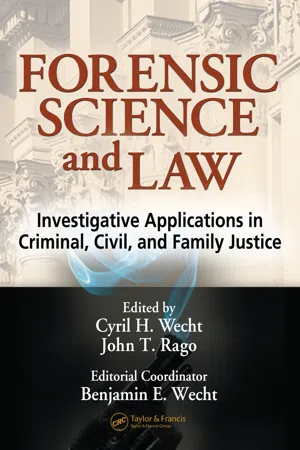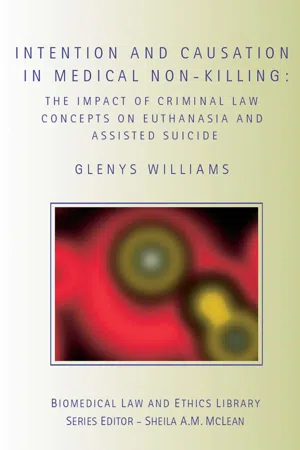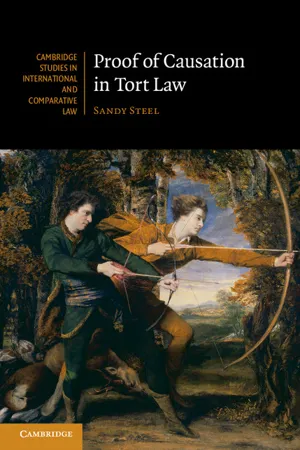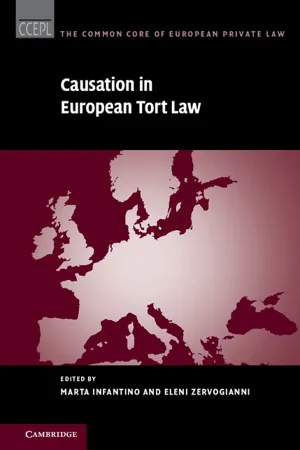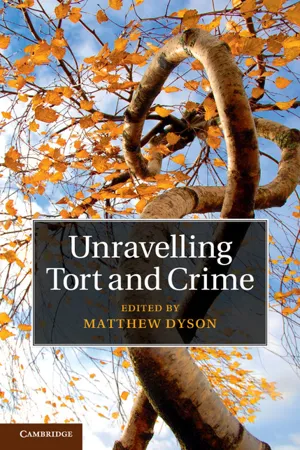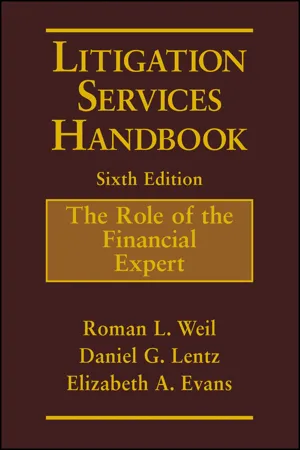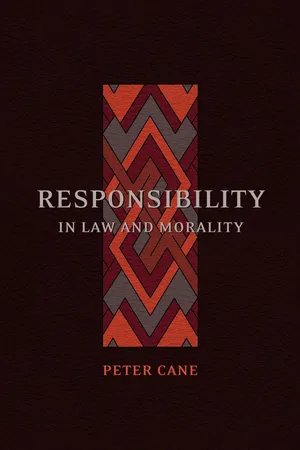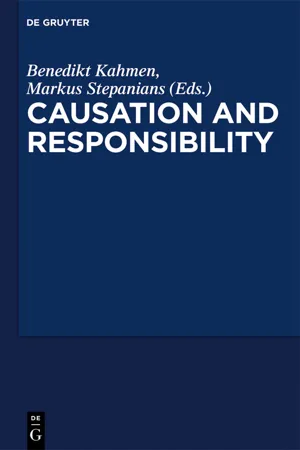Law
Factual Causation
Factual causation refers to the direct link between an action and its consequences. In legal terms, it is the determination of whether an action directly led to a specific outcome. This concept is crucial in establishing liability and determining the consequences of an action or event.
Written by Perlego with AI-assistance
Related key terms
1 of 5
11 Key excerpts on "Factual Causation"
- eBook - PDF
Forensic Science and Law
Investigative Applications in Criminal, Civil and Family Justice
- Cyril H. Wecht, John T. Rago, Cyril H. Wecht, John T. Rago(Authors)
- 2005(Publication Date)
- CRC Press(Publisher)
applicable standard of care.” 158 “A breach of duty occurs when [a] [d]efendant fail[s] to exercise reasonable care under the circumstances.” 159 Causation. Causation is a process by which “A” brings about “B”. In tort law, causation is the process by which the actions of one person or entity bring about harm to another person or entity. It should come as no surprise that a defendant should not be liable if what he did or did not do was not the cause of the plaintiff’s loss. There are two “aspects” to causation. In an unpublished opinion, the Ohio Court of Appeals has explained these two aspects in the following words: In determining whether a negligent party may be held liable for a plaintiff ’s inju-ries, courts must examine two aspects of causation: actual causation and proxi-mate causation. First, a court must determine whether the negligent party was the cause in fact of the plaintiff ’s injuries; that is, whether the plaintiff would have suffered injury but for the defendant’s negligent act. In Anderson v. St. Francis-St. George Hosp., Inc. the court described the cause in fact test as follows: The standard test for establishing causation is the sine qua non or “but for” test. Thus, a defendant’s conduct is a cause of the event (or harm) if the event (or harm) would not have occurred but for that conduct; conversely, the defen-dant’s conduct is not the cause of the event (or harm) if the event (or harm) would have occurred regardless of the conduct. Once the court determines that the defendant’s negligent act constitutes the “but for” cause of the plaintiff’s injuries, the court must examine whether the defen-dant’s negligence was the proximate or legal cause of the plaintiff’s injuries. We note that it is a basic and well-settled concept that negligence is without legal consequence unless the negligent act is a proximate cause of the plaintiff’s injury. - eBook - ePub
Questioning Causality
Scientific Explorations of Cause and Consequence across Social Contexts
- Rom Harré, Fathali M. Moghaddam, Rom Harré, Fathali M. Moghaddam(Authors)
- 2016(Publication Date)
- Praeger(Publisher)
77 Charles E. Carpenter, Concurrent Causation 83 U. Pa. L. Rev. 941, 947 (1935).In one respect, the inquiry into actual causation is simpler in law than in other disciplines. In law, the court ordinarily asks not “What are the causes of X event?” but a much narrower question: “Did a particular act or omission by actor A cause a particular injury to actor B?” The causation issue is narrowly focused in that manner because the issue of causation arises in the context of a lawsuit in which one party claims that another party caused him harm. The lawsuit typically identifies a single act or omission by the defendant that is alleged to have caused the injury or loss to the plaintiff; other factors that might be claimed to be causal contributors are often regarded as simply background conditions. Moreover, the law requires not just that the defendant’s conduct cause the harm at issue, but that the wrongful aspect of the defendant’s conduct cause the harm.8 This focus on a single act or omission, and only on the negligent aspect of that act or omission, allows judges and juries to focus on the effect of the defendant’s negligence, and not to have to make judgments about the effect of multiple other conditions that may have had some causal relationship to the plaintiff’s injury.8 This point is discussed in Richard W. Wright, Causation in Tort Law, 73 Cal. L. Rev. 1735, 1759 (1985).The most commonly employed test for finding Factual Causation in negligence cases is the “but-for” or “sine qua non” test, which has been characterized as “a familiar part of our legal tradition.”9 Under that test, if an injury would not have occurred “but for” the wrongful conduct that is at issue, the wrongful conduct is said not to be a “cause” of the injury. Put more precisely, under the but-for test negligent conduct is not regarded as a cause of harm if the plaintiff would have sustained the harm even if the defendant had not been negligent. The choice of the but-for test has been explained by saying that it “seems to be the best the law can do in its effort to offer an approximate expression of an accepted popular attitude toward responsibility.”10 - eBook - ePub
Intention and Causation in Medical Non-Killing
The Impact of Criminal Law Concepts on Euthanasia and Assisted Suicide
- Glenys Williams(Author)
- 2007(Publication Date)
- Routledge-Cavendish(Publisher)
The inquiry into the cause of death is, roughly, something like this: We take all the factors which are ‘but-for’ causes, but for these factors the patient would not have died in that way and at that time. There will be a great many such factors, and we do not actually assemble them all, but rather restrict our selection of the cause from among them.(Brock 1989b: 128)A ‘but-for’ (otherwise known as a ‘factual’) cause is the traditional distinction the courts make between factual and legal causation. The effect of this distinction is that whereas a person may be the factual cause of a consequence, he may not necessarily be its legal cause. This, like the absence of a direct causal link, acts as a limit on liability, but there are also other limits developed by the courts which will be analysed in this chapter.3 One of these is where there has been an intervening event (known as a novus actus interveniens) which can break the chain of causation between the original event and the consequence. An analysis of these cases (loosely divided into firstly, coherent principle and secondly, withdrawal of treatment following injury by a perpetrator) will show that, again, the doctor is invariably held not to be the cause of death in either. Indeed, even more than this, the resulting picture will show that neither doctors (R v Smith ([1959] 2 QB 35) and R v Cheshire ((1991) 93 Cr App R 251)), patients (R v Blaue ([1975] 1 WLR 1411)) nor the police (R v Pagett ((1983) 76 Cr App R 279)) will be held to have caused a death. In such circumstances, blame has been firmly placed at the feet of the original culpable actor.Another possible limitation on liability relates to the relevance of foresight (as opposed to intention) as the mental element and finally, the requirement for a duty of care acts as a limiting factor in omissions cases as there can be no liability without it. An analysis of court decisions relevant to each limiting factor, taken together with an examination of the law as it relates to causation and omissions (with continued use of the doctor/interloper distinction), will illustrate how intention and causation are not, and cannot be the decisive factors here. Rather, decisions are based on unstated criteria such as policy and intuition which in themselves depend on full consideration of relevant contextual factors. - eBook - PDF
- Sandy Steel(Author)
- 2015(Publication Date)
- Cambridge University Press(Publisher)
2 See Introduction, 7–10, for a catalogue of the sources of empirical uncertainty. 3 For example, if one accepts that causal chains are broken by ‘free, deliberate, and informed’ actions (for this view, see H.L.A. Hart and T. Honoré, Causation in the Law, 2nd edition, 41–4 and passim), one might be uncertain as to whether a certain act should be classified as truly ‘free’ for this purpose. This is a conceptual uncertainty. 4 For the designation of these causal concepts as ‘factual’ or ‘natural’ aspects of the causal inquiry, see, for example, A. Spickhoff, Folgenzurechnung im Schadensersatzrecht, 12–19; J. Stapleton, ‘Factual Causation’, 468. 15 different proof rules apply depending on the stage of the legal inquiry at which causation is involved 5 and, second, because it will assist in delimit- ing what constitutes a causal question, rather than some other question relevant to liability. Causal concepts in tort law English, German, and French tort law each recognise that if c and e are specific distinct events or states of affairs, and c and e have occurred, c was a cause of e, if and only if: (a) e would not have occurred had c not occurred or (b) c contributed to the production of e (i) The core case of contribution in each system is where c plays a positive role in the causal process by which e occurs. (a) is the ‘but-for’ test of causation and is briefly explained first. (b) refers to the causal concept which is employed by each system – though not termed by each system as the concept of ‘contribution’ – when it accepts that c was a cause of e even where it is known that e would have occurred regardless of c or where it is not established that e would not have occurred without c. - eBook - PDF
- Marta Infantino, Eleni Zervogianni(Authors)
- 2017(Publication Date)
- Cambridge University Press(Publisher)
Yet, what is worth stressing here is the inherent context-dependency of reasoning about causation. Causal attributions, be they legal, lay or scientific, never occur in a vacuum. Rather, they are always performed within knowledge structures that affect the causal relationships which are drawn. In this light, judgments about causation inside and outside courtrooms appear to be determined not only by the allegedly ‘objective’ sequence of events 6 For a (critical) overview of this approach, see, among others, C. Quézel-Ambrunaz, Essai sur la causalité en droit de la responsabilité civile (Paris: Dalloz, 2010), pp. 9–10, 25–6, 59–60; J. Stapleton, ‘Legal Cause: Cause-in-Fact and the Scope of Liability for Conse- quences’ (2001) 54 Vanderbilt Law Review 941 at 969; H.L.A. Hart and A.M. Honoré, Causation in the Law, 2nd ed. (Cambridge: CUP, 1985), pp. 30, 96–7, 341. 7 L. Green, ‘Are There Dependable Rules of Causation?’ (1929) 77 University of Pennsylvania Law Review 601, 620 ff.; more recently, T. Weir, An Introduction to Tort Law, 2nd ed. (Oxford: OUP, 2006), p. 72; B. Markesinis and H. Unberath, The German Law of Torts, 4th ed. (Oxford-Portland: Hart, 2002), p. 687. 8 See the works quoted in the previous footnote, as well as M. Taruffo, La semplice verità. Il giudice e la costruzione dei fatti (Bari: Laterza, 2009), esp. p. 213 f.; C. Miller, ‘Epidemiology in the Courtroom: Mixed Messages from Recent British Experience’ (2012) 11 Law, Prob- ability and Risk 85–99; W. Mummenhoff, Erfahrungssätze im Beweis der Kausalität (Cologne: Heymann, 1997), pp. 44, 47. c a u s a ti o n, c og ni t i on , c u lt u r e 5 to be evaluated, but also by the constraints limiting the evaluator’s knowledge structure in giving meaning to those events. - eBook - PDF
- Matthew Dyson(Author)
- 2014(Publication Date)
- Cambridge University Press(Publisher)
9 Causation in tort law and criminal law: unity or divergence? sandy steel * This chapter does four things. First, it sets out the different legal contexts in which the concept of causation is relevant to the rules of English criminal and tort law. Second, it maps out and compares each area of law’s understanding of the concept of causation. Third, it briefly discusses issues surrounding proof of causation in both domains. Finally, it argues that criminal law and tort law should converge on the substan- tive causal requirements for liability in situations where the issue is whether a defendant’s conduct caused an injurious outcome. 1. Causal questions in crime and tort Many legal rules in criminal and tort law make use of the concept of causation. There are four ways in which they do so. A. Causation as a constitutive element of a crime or tort Causation may be a constitutive element of a crime or tort in the sense that the defendant must cause some outcome in order to commit the crime or tort. If the crime or tort is a legal wrong (i.e. it consists of the breach of a legal duty), 1 causation of an outcome may form part of the legal wrong, 2 for example, the duties imposed by the tort of negli- gence and the crime of gross negligent manslaughter. Alternatively, it may simply be a requirement of the tort or crime, for example, (arguably) the * I would like to thank Matthew Dyson and Dennis Baker for very helpful written com- ments. Errors are mine. 1 For an exploration of this, see Chapter 5, by Stevens, in this volume. 2 There are thus, in John Gardner’s terminology, causal and non-causal wrongs: J. Gardner, ‘Moore on Complicity and causality’ (2008) 156 University of Pennsylvania Law Review PENNumbra 432, 432. 239 rule in Rylands v. Fletcher or the offence of causing death whilst uninsured under section 3ZB of the Road Traffic Act 1988. - eBook - ePub
Litigation Services Handbook
The Role of the Financial Expert
- Roman L. Weil, Daniel G. Lentz, Elizabeth A. Evans(Authors)
- 2017(Publication Date)
- Wiley(Publisher)
13Aside from these two situations, the but-for and substantial factor tests should produce the same legal conclusion.14 This congruence follows from the fact that “the substantial factor test subsumes the but-for test. If the conduct which is claimed to have caused the injury had nothing at all to do with the injuries, it could not be said that the conduct was a factor, let alone a substantial factor, in the production of the injuries.”15Standards for Actual Cause in Negligence Cases
Sine qua non (but-for test): But for the defendant’s conduct, the plaintiff would not have suffered damages. Substantial factor test: Even though it was not the only cause, the defendant’s conduct was a substantial factor causing the plaintiff’s damages. (ii) Legal Cause Proof of actual cause is alone insufficient to establish the defendant’s liability for negligence; the plaintiff must show that the defendant’s conduct is also the legal cause of the damages.16 Legal cause “tempers the expansive view of causation [in fact].”17 As one court has explained:The law does not undertake to charge a person with all the possible consequences of a wrongful act, but only with its probable and natural result; otherwise, the punishment would often be entirely disproportioned to the wrong, thereby impeding commerce and the ordinary business of life, and rendering the rule [of causation] impracticable.18Thus, one can best understand legal cause as demarcating a certain point beyond which “the law arbitrarily declines to trace a series of events.”19 The determination of this point is not a matter of “logic” but instead of “practical politics,” reflecting considerations “of convenience, of public policy, [and] of a rough sense of justice.”20 - eBook - PDF
- Peter Cane(Author)
- 2002(Publication Date)
- Hart Publishing(Publisher)
This link between obligation (“what our responsibilities are”) and causation is also a feature of causal judgments in the moral and political domains. 35 In the context of responsibility for bad outcomes, the reason why cases such as “injur-ing by blows” seem to lie at the core of causation, while cases such as “failing to prevent harm” and “inducing a person to do harm” seem to be marginal cases of causation, is that, both in law and morality, obligations of the type breached by a person who injures another by blows are more widespread and general in their incidence and application than obligations of the type breached by a per-son who fails to prevent harm or induces another to do harm. There are few forms of legal liability for outcomes that can meaningfully be called “non-causal”. In civil law, an example is the restitutionary liability of the passive recipient of a mistaken payment or the passive beneficiary of a fraud. Even in this case, the recipient is part of the history of the transition to 132 Responsibility and Causation 35 Smiley (1992), 185–95. the relevant outcome (i.e. receipt of the payment). If the recipient had not existed, and had not been in the right place at the right time (as it were), they would never have received the payment. On the other hand, since, by defini-tion, the recipient did nothing to attract the payment, and was under no duty to prevent its being made, there seems no causal reason to single out the recipi-ent as legally responsible for the making the payment. In other words, the rea-son why this form of liability is not cause-based is that it is not conduct-based. Causes link legally proscribed conduct with legally proscribed outcomes. Here there is a legally proscribed outcome, namely the receipt of a payment as a result of mistake or fraud. But that outcome is not traceable to any legally pro-scribed (or even any legally relevant) conduct of the person under the obliga-tion to repair the outcome, i.e. - Benedikt Kahmen, Markus Stepanians, Benedikt Kahmen, Markus Stepanians(Authors)
- 2013(Publication Date)
- De Gruyter(Publisher)
Ingeborg Puppe The Concept of Causation in the Law Introduction All of someone ’ s responsibility for an event is based on a relation of causality between his behaviour (doing or omitting) and this event. Whatever is required for justifying this responsibility and distinguishing degrees of it, it is a property of this causal relation or is connected to it. This holds for the law as well as for morality. So it is only natural that legal scholars have followed the attempts of philosophers to determine the relation of causality with great interest and with the readiness to learn from them. But philosophers could also have taken up some ideas from jurists. Modern philosophy of causality has only recently dis-covered the problem of determining a singular cause and its logical relation to the whole cause and its effect, namely in the mid-20 th century. In contrast to this, legal scholars have always been concerned with this problem. It also seems to me that though philosophy deals very thoroughly with the problem of preempting causality, it somewhat neglects the problem of double or multiple causality. Multiple causality exists if several factors in a causal explanation can be substituted for each other without one preempting the other. This problem oc-curs in jurisprudence for example if in an accident, several people behave so wrong that each one ’ s behaviour is sufficient to explain the accident. In the last decades, philosophical discussion of causality has seen a turn-around. After centuries of a nearly unchallenged generalist notion of causality, according to which causality consists in the sequence of cause and effect being subsumable under a general law, philosophers and philosophically-mind-ed jurists recently turned to the notion of a causa efficiens , in particular to a physicalist notion of causality. The physicalist notion of causality depicts the cause as a transfer of energy.- eBook - PDF
- Richard Goldberg(Author)
- 2011(Publication Date)
- Hart Publishing(Publisher)
Causation need not be determined by scientific precision. It is, as stated by Lord Salmon in Alphacell Ltd. v Woodward, [1972] 2 All E.R. 497, at 490: [‘essentially a practical question of fact which can best be answered by ordinary common sense rather than abstract metaphysical theory’]. The legal or ultimate burden remains with the plaintiff, but in the absence of evidence to the contrary adduced by the defendant, an inference of causation may be drawn although positive or scientific proof of causation has not been adduced. . . . 7 In Canadian law, then, a limited scientific understanding of the aetiology of a plaintiff’s condition does not, in and of itself, pose an insurmountable hurdle to proving cause-in-fact. The gap created by what we do not know can be bridged by an inference of cause-in-fact, drawn from what we do know, where such an inference is supported by ‘common sense’ and by a ‘robust’ and ‘pragmatic’ treatment of evidence. 4 [1988] 1 All ER 871 (HL). 5 [1972] 3 All ER 1008 (HL). There, the employer’s failure to provide washing facilities for employees was one of several potential sources of the cause of the plaintiff’s dermatitis. 6 Snell v Farrell [1990] 2 SCR 311, 324. (Emphasis added). 7 ibid 328, 330. Inferring Cause in Fact and the Search for Legal ‘Truth’ 95 Of course, the sort of gap – or, more precisely, the sort of factual uncertainty – in Snell was nothing new. The House of Lords had confronted the same problem just three years earlier in Wilsher . 8 There, the plaintiff was a prematurely born infant who was negligently oxidised through his umbilical vein instead of an artery, with the result that he was over-supplied with oxygen. He was then negligently monitored, which again exposed him to unsafe oxygen levels. While he subsequently developed retrolental fibroplasia (resulting in blindness), the over-oxidisation was only one possible cause. - eBook - PDF
- (Author)
- 2011(Publication Date)
- Siber Ink Publishers(Publisher)
I suspect, therefore, that nothing in my presentation today will surprise or challenge Professor Honoré, no more than my essays twenty years ago surprised or challenged Dr Glover. But I hope that, just like Dr Glover, so Professor Honoré will listen patiently and politely to what I have to say and then go on, equally patiently and politely, to explain my errors. I PROFESSOR HONORé’S UNDERSTANDING OF CAUSE IN FACT To introduce Professor Honoré’s views on causation to you, I will contrast them with the approach taken to causation by South African law, in particular its law of delict. * BA LLB (Cape Town) BA DPhil (Oxon). Professor of Private Law in the University of Cape Town. CAUSE I N FAC T 51 In the South African law of delict, the question whether a defendant’s culpable and wrongful act caused a plaintiff’s harm is resolved by two distinct enquiries.1 The first is whether the act was a cause in fact of the harm. According to the South African law of delict, whether an act was a cause in fact of harm is to be determined by application of the so-called ‘but-for’ test. The but-for test states that an act is a cause in fact of harm if and only if, but for the act, the harm would not have occurred. As Corbett CJ pointed out, the test is thus designed to determine whether an act was a conditio sine qua non , or necessary condition, for the occurrence of harm.2 The second enquiry is whether, if the act was a cause in fact of the harm, it was linked sufficiently closely or directly to the harm for legal liability to ensue. According to the South African law of delict, that is to be determined by applying a ‘flexible’ or ‘supple’ test. This flexible test requires, on the one hand, consideration of factors such as reasonable foreseeability, directness and the absence or presence of a novus actus interveniens . It requires, on the other hand, consideration of legal policy, reasonableness, fairness and justice. The first set of factors is subsidiary to the second.
Index pages curate the most relevant extracts from our library of academic textbooks. They’ve been created using an in-house natural language model (NLM), each adding context and meaning to key research topics.
